
New Items - Paintings
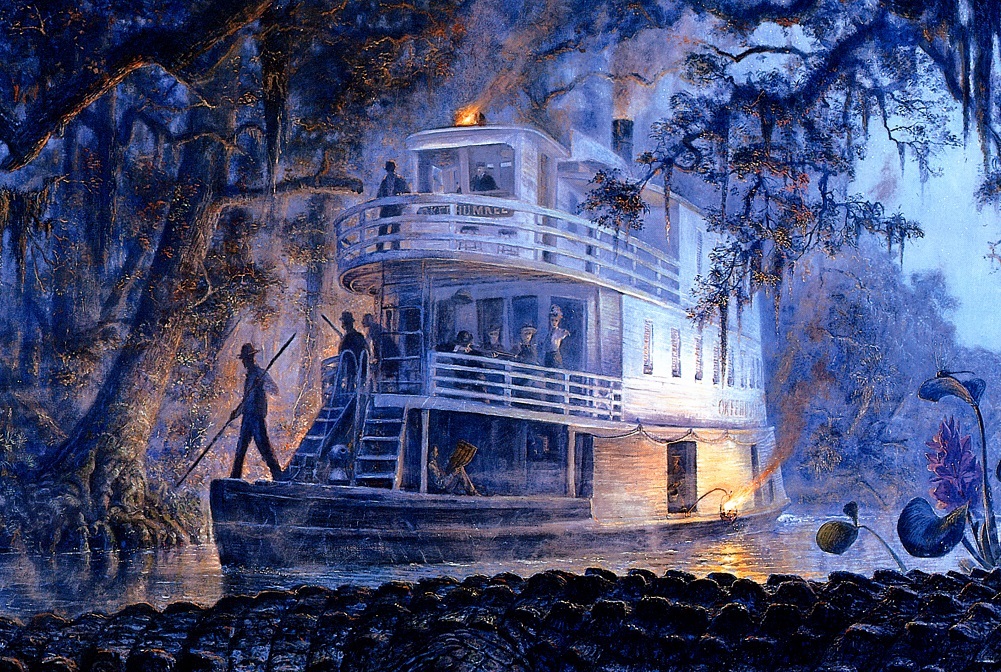
THE STEAMBOAT OKEEHUMKEE ON THE OKLAWAHA RIVER IN FLORIDA - LATE 1800'S
THE OKEEHUMKEE ON THE OKLAWAHA RIVER
Detail from a Painting by Christopher M. Still
Oil on Linen 48" x 126"
Scanned from an unframed signed and numbered limited edition print.
Size with border 12 x 27 1/2 inches. $125.00
The Okeehumkee on the Oklawaha | photo-studio-r (christopherstill.com)
The Civil War is over and the slaves free. It is the late 1800s, and a small steamboat winds its way through the serpentine curves of the Oklawaha River at night. Its passengers are visitors and adventure seekers from northern states. As they pass by giant cypress trees and under Spanish moss, their way lit by fire, these first Florida tourists are thrilled by white-tailed deer, large, plumed birds, and huge, prehistoric-looking alligators that appear out of the shadows along the river's edge. The stories they had read about the natural beauty and wonders of this southern state were certainly true.
While tourists idly cruised in these "floating palaces," life was forever changing for the pioneers, trappers, farmers and former slaves who lived and worked here. Florida was no longer on its way to becoming another cotton state. New businesses like citrus farming, phosphate mining, and tourism were pushing the rapid growth of transportation industries, and the state was ripe with opportunity. Investors from the north came, not for the scenery, but to get in on the expected boom, and to take advantage of the confusion and disarray left in the wake of the war.
The steamboat OKEEHUMKEE was the longest serving steamboat on the Oklawaha route. Such shallow draft steamers were specially built for navigating Florida's narrow winding rivers. The engine and paddle wheel were concealed in the lower part of the boat. They were often overloaded with passengers, and the reckless shooting of guns, along with the annoyance of bugs and branches, prompted some to make the return trip by train.
Two men were required to be stationed in the pilot house at night. The pilot commanded the crew and directed the wheelman.
A box on top of the pilothouse held burning pine knots to help light the way. It also allowed the hunters and sightseers to view wildlife along the river.
Typically a member of the crew stood at the front of the steamboat with a long pole to help the pilot navigate around potential hazards such as sunken trees and overhanging limbs.
Postcards from this era show iron baskets, used for additional light, on the sides of steamers. Aged parts of pine trees called pine knots, pitch knots, or lighter knots were usually burned in the baskets. These knots were full of resin, lit easily, and burned for a long time.
A deckhand stands ready with a bucket of water to extinguish the flame in the iron basket.
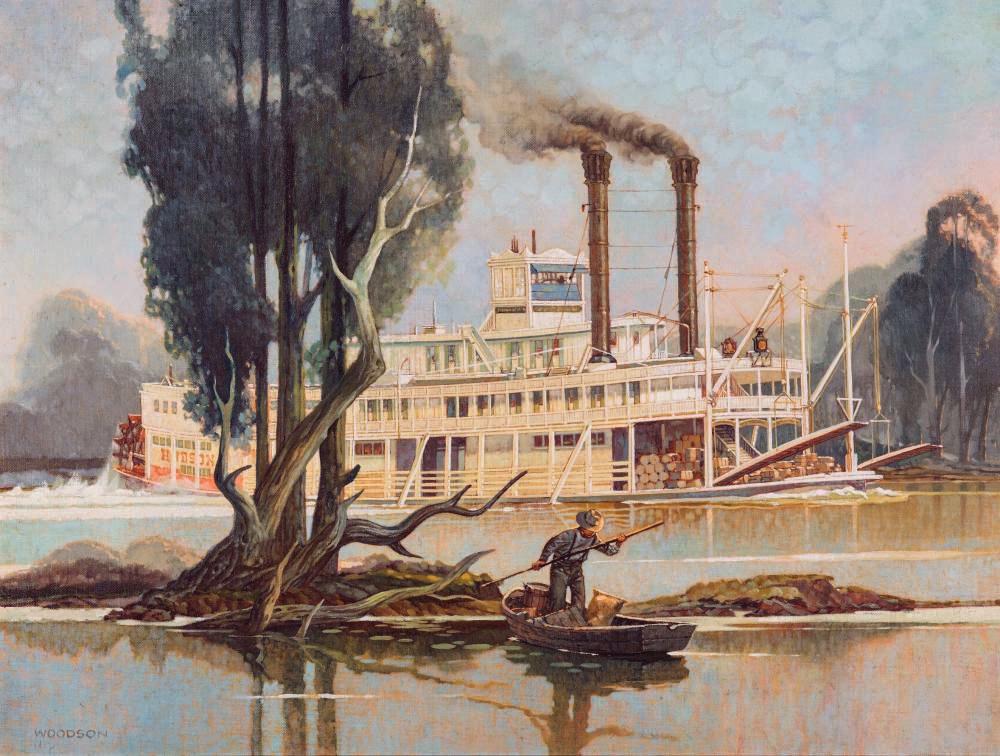
John Woodson was a Virginian (1913 - 1992) who went by "Jack" and his friends called him by the nickname "Waddie."
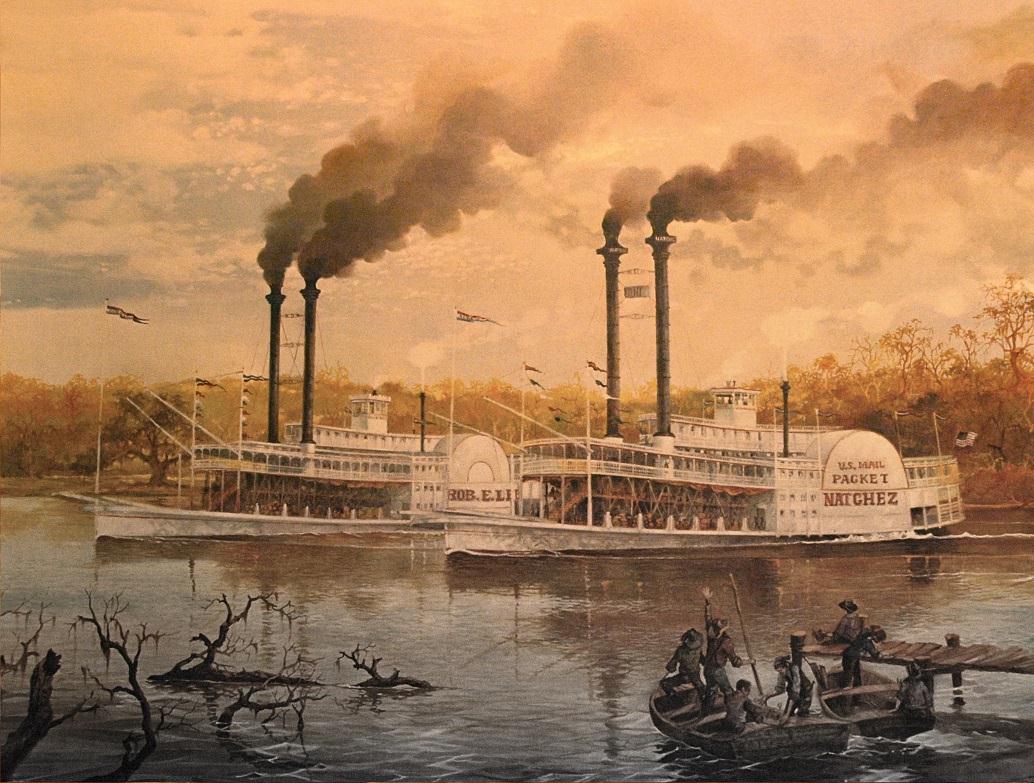
Revised caption: Rucker's "THE RACE" between the NATCHEZ and the "ROB" E. LEE
Here is Robert Rucker's version of the NATCHEZ vs. ROB'T E. LEE that he entitled "THE RACE." He made a short cut by abbreviating ROB'T to ROB on the paddlebox employing his artistic license apparently although it compromised authenticity.
The best things about the painting is the subtlety of the clouds in the sky and the way he rendered the smoke from the stacks from opaque to translucent. He had to have had an amazing technique to achieve that effect.
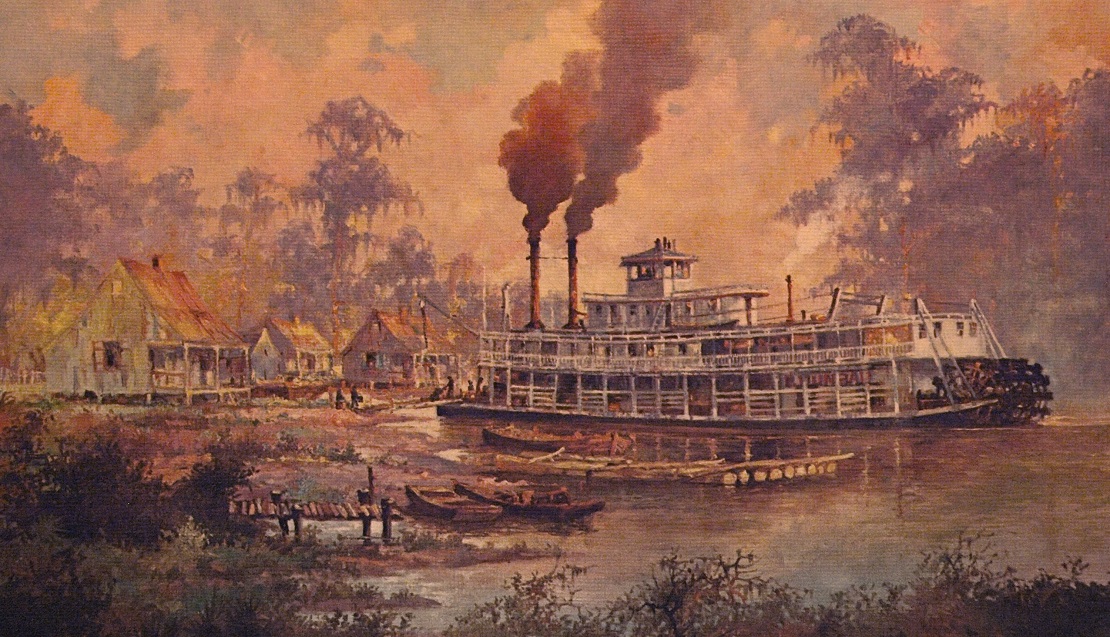
Robert Rucker's SUMMER STEAMBOAT featuring the sternwheeler R. DUNBAR, Robert Rucker's SUMMER STEAMBOAT, making a landing at a small bayou community in Louisiana.
The name of the boat at the stern is apparently R. DUNBAR, a sternwheel packet with wooden hull 160' x 29.4' x 6.4' built at Howard's shipyards in 1895.
The name of the boat at the stern is apparently R. DUNBAR, a sternwheel packet with a wooden hull 160 ft. x 29.4 ft. x 6.4
built at Howard's shipyards in 1895.
She was owned by Ryman Line in Nashville, Tennessee and operated on the upper Cumberland River until 1918 when she was sold to the Liberty Line, renamed GENERAL CROWDER and moved tothe upper Ohio River.
When the Liberty Line ceased operations in 1926, GENERAL CROWDER was sold to New Orleans interests but burned at Slidell, Louisiana before operations started.
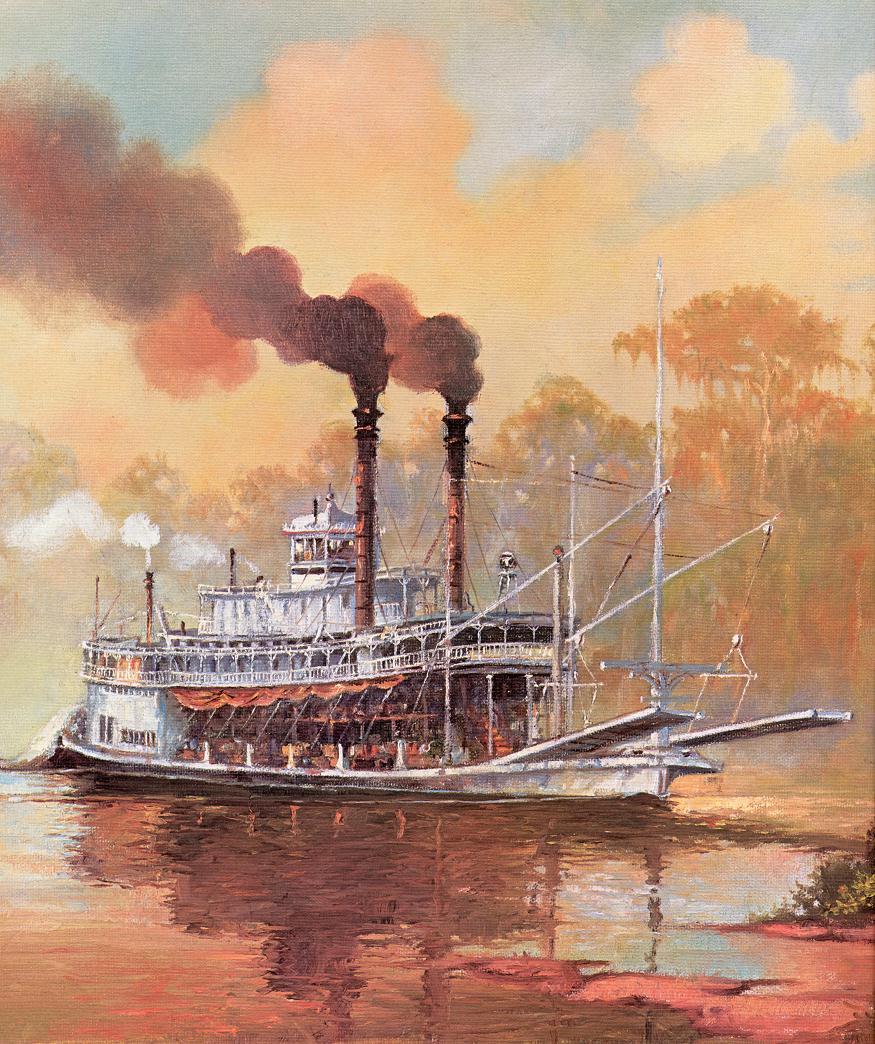
An exceptionally fine representation of an unidentified steamboat in this detail from a painting by Robert Rucker entitled SUMMER STEAMBOAT.
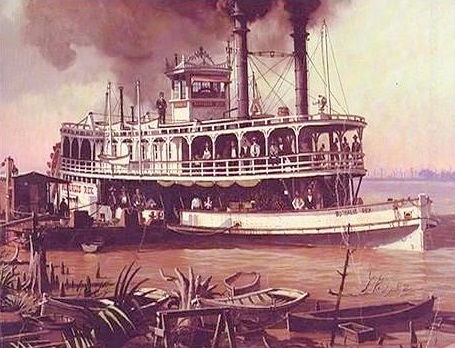
The Borealis Rex painting James L. Kendrick III
FOUND THIS SMALL FILE ONLINE, IT WAS COMMISSIONED BY CAMERON COMMUNICATIONS TO BE MADE INTO ONE OF THEIR ANNUAL PRINTS, IN THIS CASE FOR 1986.
WILL HAVE TO KEEP AN EYE OUT FOR A COPY OF THIS PRINT ON EBAY ETC. TO SEE IF IT TURNS UP.
THIS COULD GO WITH KENDRICK'S PAINTINGS OR WITH THE BOREALIS REX IMAGES WE HAVE IN 15TH & 16TH PLACE ON THIS PAGE: Advertising for Steamboats and the Trade
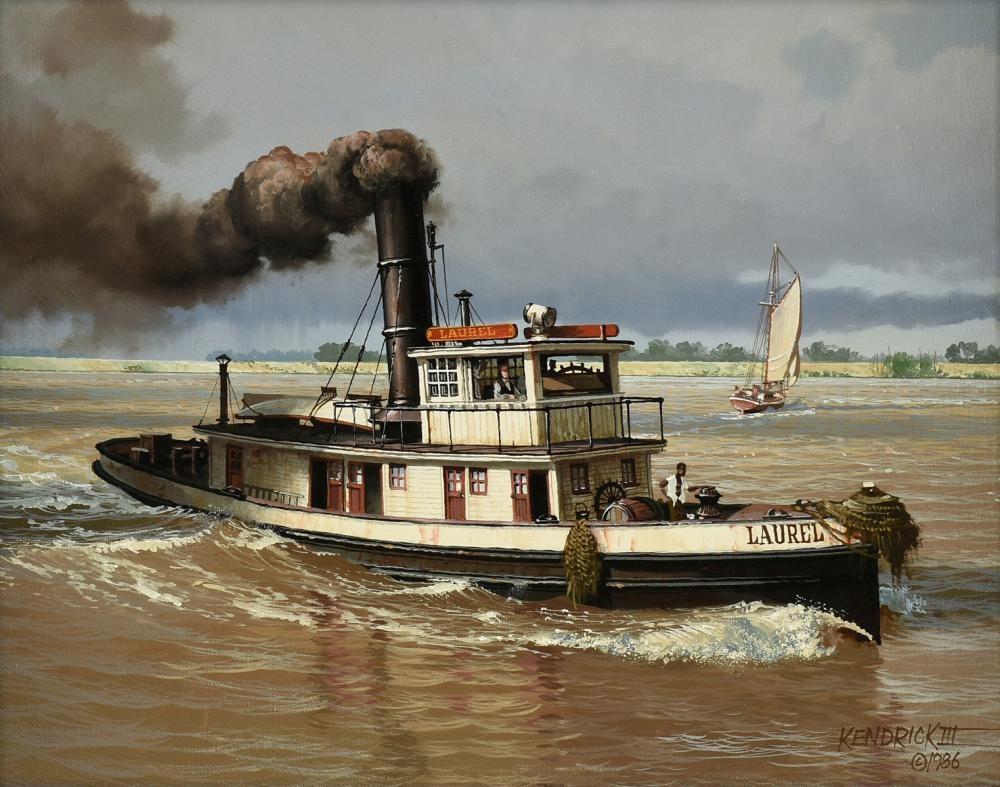
Steam Tugboat LAUREL painting by James L. Kendrick III 1986
Steam Tugboat LAUREL
painting by James L. Kendrick III 1986
Sold February 2020
Simpson Galleries
Houston, Texas
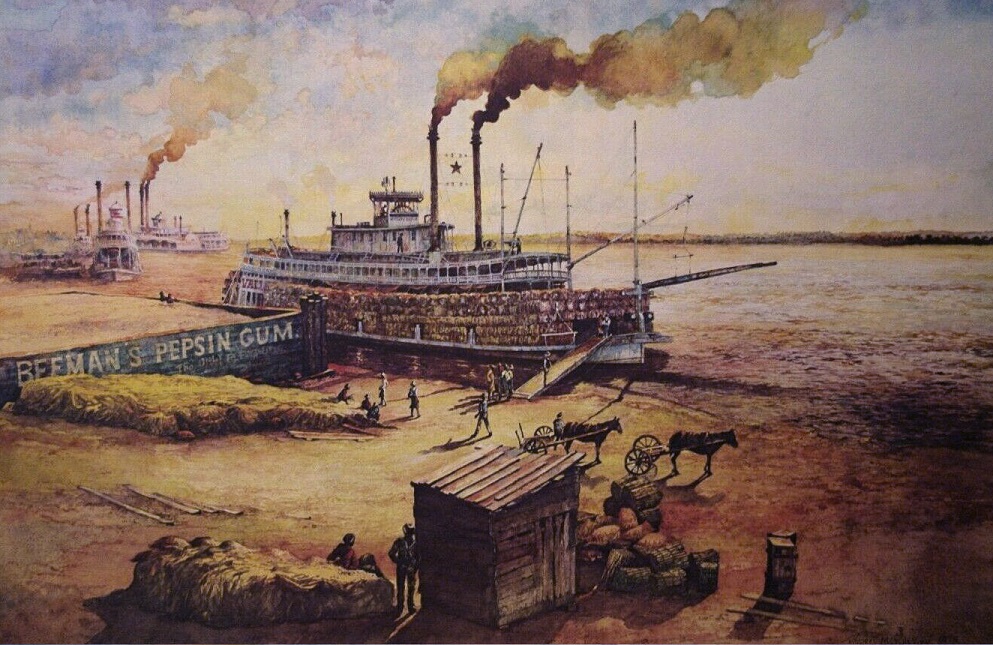
PRINT OF ROBERT RUCKER'S PAINTING "BEEMAN'S WHARF"
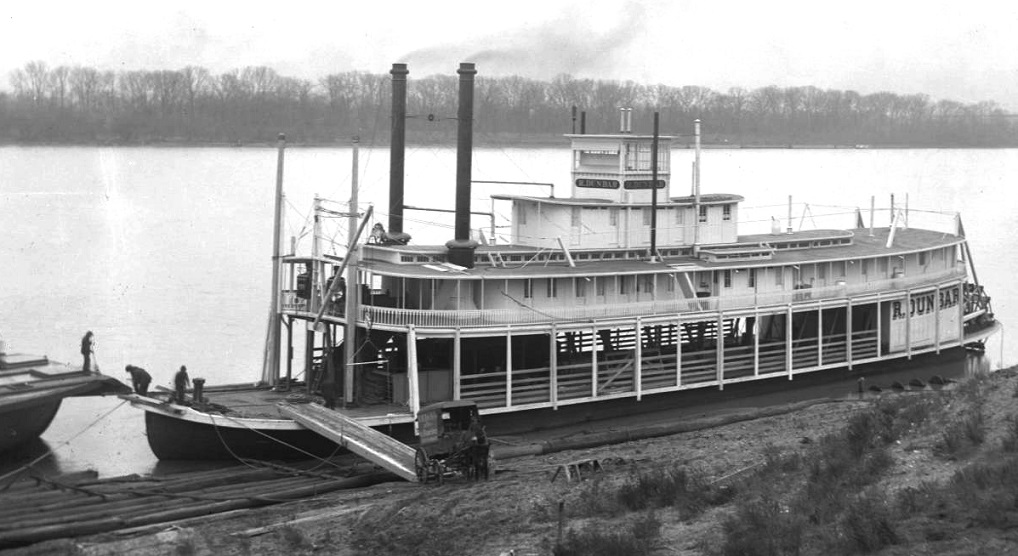
Photo of the Sternwheeler R. DUNBAR to accompany Rucker's SUMMER STEAMBOAT painting
Photo source: digital.library.louisville.edu
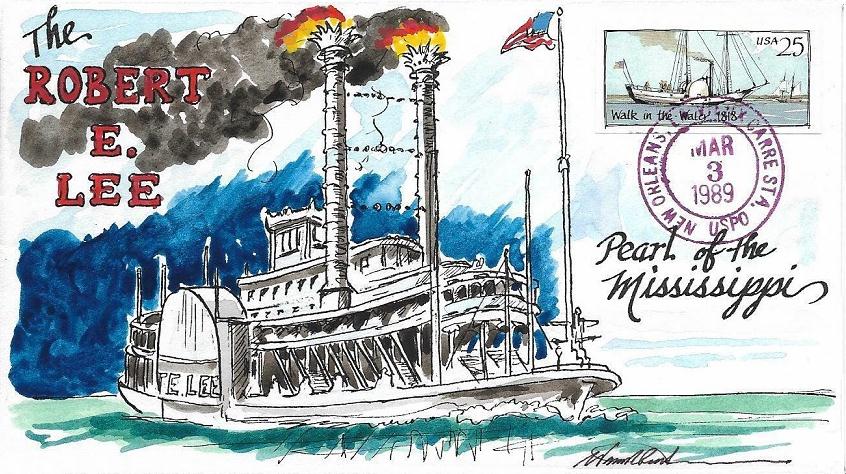
Book Cover Graphic "Days and Deeds"
Sidewheeler Express hand painted over print A WORKHORSE LOADS ITS CARGO
STEAMBOAT ROB'T E. LEE "Pearl of the Mississippi" based on Dean Cornwell's painting of the 1870 race with the NATCHEZ HAND PAINTED by "Wild Horse" Cancelled March 3, 1989 in New Orleans, LA 10th of 25 hand painted over an apparently printed black & white envelope 25 cent Riverboat Stamp cancelled Steamboat WALK IN THE WATER 1818
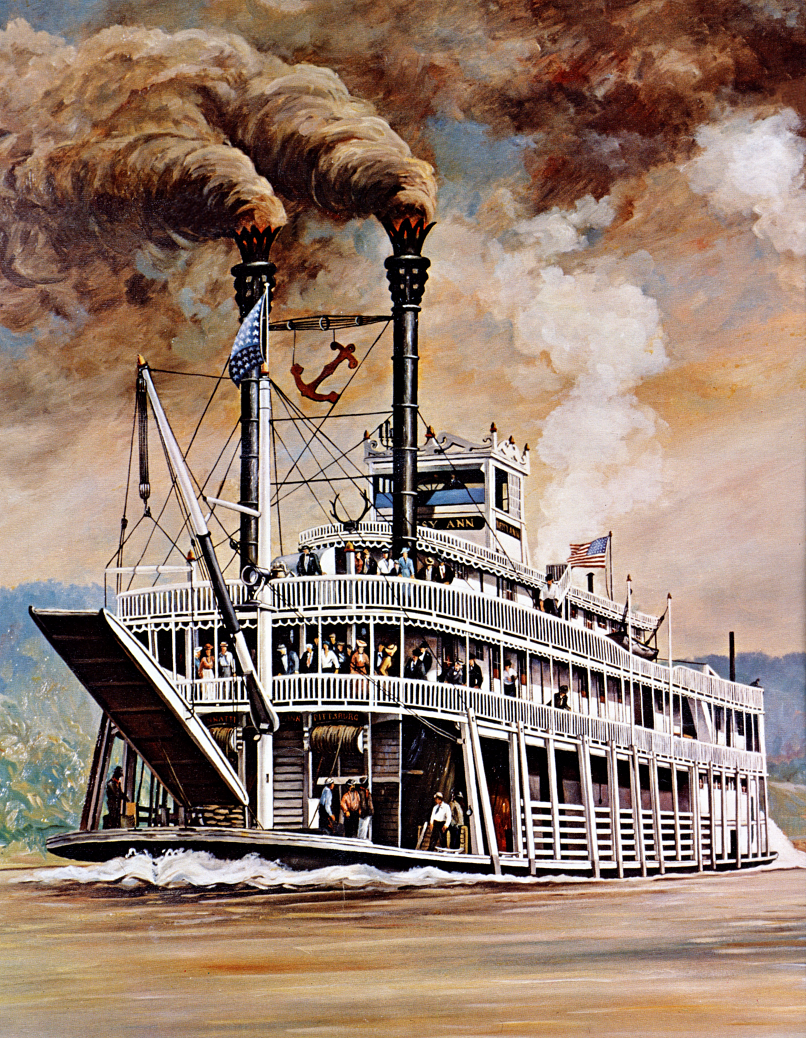
Detail of the BETSY ANN from a lithograph of a canvas depicting the 1930 race between the BETSY ANN & TOM GREENE painted by WILLIAM E. REED in 1970.
The image of the BETSY ANN on the left side of the canvas appears to have been Influenced by the same vertical pose that Dean Cornwell painted so spectacularly in his colorful and powerful rendering of the steamboat.
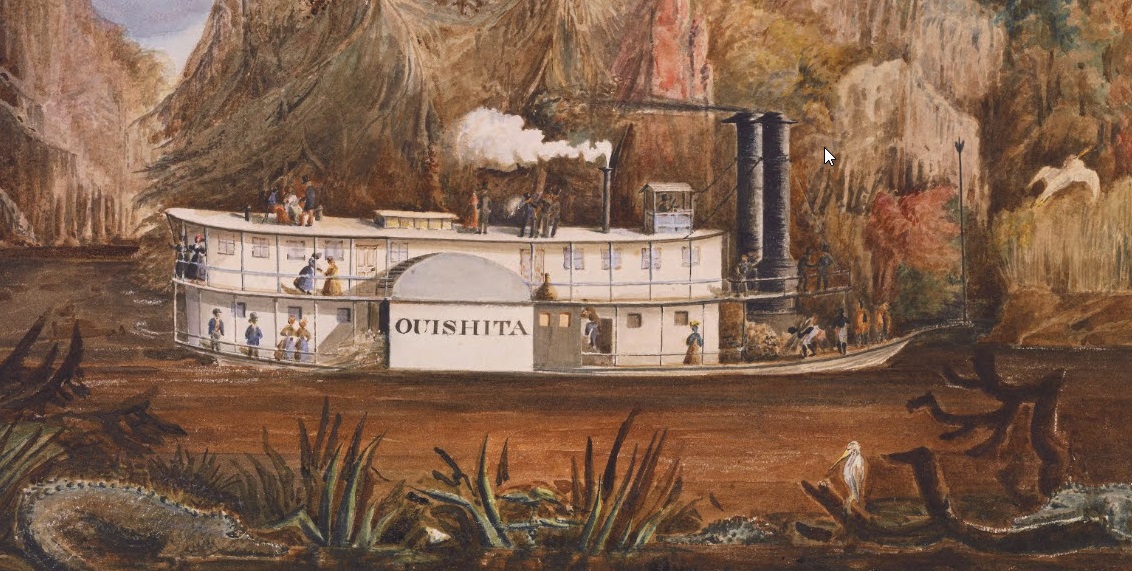
The steamer OUISHITA on the Red River, Louisiana Territory in 1836
A WONDERFUL EARLY PAINTING THE SIDEWHEELER "OUISHITA" IN THE COLLECTION OF THE AMON CARTER MUSEUM IN TEXAS. THE WEIRD FOLIAGE IN THE BACKGROUND & THE ALLIGATORS IN THE FOREGROUND LEND AN EXOTIC ATMOSPHERE TO THE PICTURE.
LATER IN THE CENTURY THE SPELLING OF "OUISHITA" WOULD BE CHANGED TO "OUACHITA."
IT IS UNCLEAR WHETHER LEVINGE TRAVELED TO THE UNITED STATES AND ACTUALLY PAINTED THIS HIMSELF IN 1836 OR IF IT WAS IN HIS PERSONAL COLLECTION AT HIS CASTLE IN IRELAND.
"The steamer OUISHITA on the Red River, Louisiana Territory"
Richard George Augustus Levinge, 1836
Watercolor heightened with gum glaze over graphite on paper.
8.30 inches X 12.48 inches
Amon Carter Museum of American Art
Fort Worth, Texas
Sir Richard George Augustus Levinge, 7th Baronet was born 1st of November 1811 & passed on 28th of September 1884.
Levinge was an Irish landowner and politician from Knockdrin Castle in County Westmeath. He sat in the House of Commons in the United Kingdom from 1857 to 1865. His mother was a sister of the 2nd Baron Rancliffe, who died without issue in November, 1850.
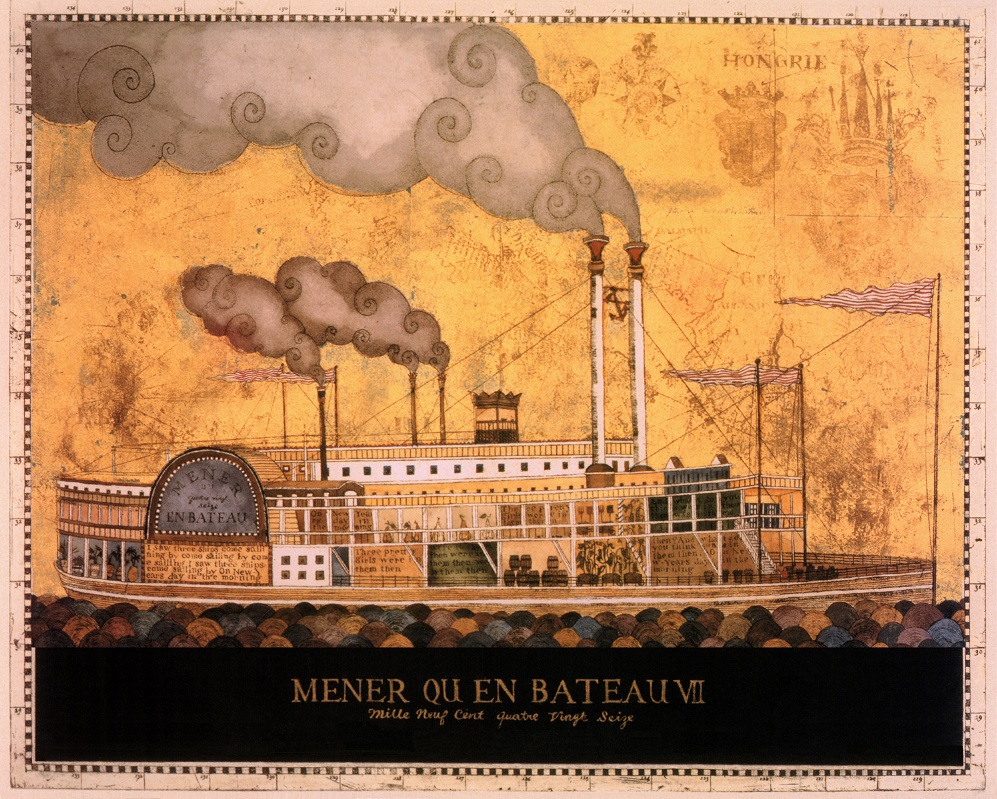
Beautiful "folk art" style painting of a steamboat
MENER QU'EN BATEAU VII
Mille Neuf Cent quatre Vingt Seize
Translates from French into English thus:
LEAD ONLY ON BOAT THE SEVENTH
Nineteen ninety-six
Scan of a print of and interesting "folk art" style painting circa 1996 of a sidewheel steamboat with some text in French which translates online as something rather ambiguous. On parts of the boat itself there is a repeated phrases in English which were derived in part from a favorite English British Christmas carol in which the words "New Years" are substituted for the word "Christmas" thus:
"I saw three ships come sailing by on New Years day in the morning." The word HONGRIE in the upper right quadrant seems to be intended as a French name for the country "Hungary."
No artist's name is detectable and the intended application of the print is uncertain, perhaps it was calendar art for the month of January 1996 in which case there could have been eleven other paintings in this style to make a total of twelve months in all.

With the exception of images credited to public institutions,
everything on this page is from a private collection.
Please contact Steamboats.com for permission for commercial use.*
All captions provided by Dave Thomson, Steamboats.com primary contributor and historian.
